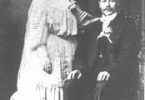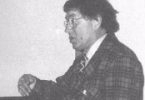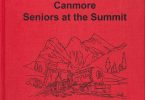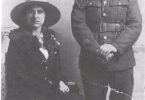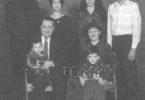I moved to Banff in 1974 from Winnipeg, Manitoba, and, in 1975, my former husband and I purchased the A-frame on Policeman’s Creek, known as the “Ginger house”. There was no street address, so the house was identified as the “Ginger House” on the road to the Restwell Trailer Park. As a photo-journalist for the Canmore Miner, I wrote articles covering council meetings, sports and community events. In 1980, I was elected for a three-year term on town council. I gained invaluable experience representing Canmore on the Calgary Regional Planning Commission and subsequently was elected to the regional planning committee, serving with Calgary Alderman Bob Hawkesworth.
My studies at the University of Calgary led to a research practicum involving Canmore coal miners and their difficulty qualifying for workers’ compensation benefits due to respiratory illnesses. I decided to fly to Beckley, West Virginia at my own expense to interview Dr. Rasmussen at the Black Lung Clinic. The following summer, District 18 of the United Mine Workers of America, which included the Canmore union, placed me on contract to research Black Lung Disease in relation to compensation benefits. Three coal miners, now deceased, travelled to Beckley, West Virginia to the Black Lung Clinic for testing. The miners were Ron Riva, Alex Borisenko and John Sanyshin from Coleman. On our trip we had the privilege of meeting with Arnold Miller in Washington, D.C., President of the International United Mine Workers of America. I remember being escorted up to his office with armed bodyguards at my side. I also was granted an interview with Dr. Lorin Kerr, who was heavily involved with Black Lung research within the union’s Occupational Health and Safety Department. Two submissions were made to the Alberta Government and the Worker’s Compensation Board hearings.
Immediately following the announcement in 1979 of the Canmore Mines closure, Ron Riva, President of the UMWA, District 18 in Canmore, asked me if I would consider the position of coordinator and chairman of the Employment Assistance Committee. This committee was established under the Tripartite Agreement with the federal and provincial governments and the Canmore Mines to assist the 100 coal miners laid-off and now unemployed. Our final report was submitted to Lloyd Axworthy, Minister of Employment and Immigration.
Two years later, in 1981, a similar committee was set up to assist the forty-two laid-off workers from the Canada Lafarge Cement Plant in Exshaw. As co-ordinator and chairman, another report was submitted to the provincial government. Fortunately, the workers were hired back before the program was due to finish.
I continue to be concerned about health-related illnesses in the work environment, namely cancers caused by asbestos in the petro-chemical industry. In the University of Calgary’s Master’s program on Resources and the Environment, my studies reflected this interest, plus regional planning.
My newspaper reporting widened to a weekly column with the Banff Crag and Canyon, called the Bow Corridor News. As a member of Canmore town council, I served on the Library Board, the Improvement District No. 8 Joint Committee, now known as the M.D. of Bighorn, as well as chairman of the economic development committee.
In 1978, following my graduation from the University of Calgary with a social work degree, I was successful in my application to be the coordinator of the Neighborhood Improvement and the Residential Rehabilitation Housing Program. Under the funding auspices of Central Mortgage and Housing, money was available to help communities to finance community enhancement projects. The residents on this committee picked the Community Centre, the Drop-in Centre and Library as funding projects.
In 1978, we formed the first local interest group to provide input to the Canmore General Municipal Plan. We later named the committee the Master Brief Committee, keeping a watchful eye on council to ensure proper planning and development decisions were adhered to.
As a charter member of the Pika Toastmasters Club in Banff, I was elected for three terms as president and served in every executive position, except treasurer. I also served as an area governor for one year, travelling to other toastmasters clubs in the Calgary region to assist the members to build up membership and to keep motivated.
I left the Bow Valley in 1986, following my divorce in 1984, and just returned to Canmore in March, 1999. Since my return, I have been involved with Bow-Cord, CPAWS (The Canadian Parks and Wilderness Society), the Valley Winds, Rundle Community and Millenium choirs. I plan to stay heavily involved with the political process in Canmore with respect to stewardship of the environment and proper planning principles to retain and enhance the quality of life and integrity of the people, animals and ecosystem in the Bow Corridor.
SILENCE
I opened the door
and soon realized the deadly silence.
Oh, Sherry, you and I together on Sunday –
restless we were.
I felt a deep sense of sadness,
intuitively sensed the end was coming.
But, with hope in my heart
you would see the morning
and I could say ‘Hi, Sherry’.
However, death was in the wind.
I comforted you as your life quickly ended.
Fourteen years we comforted each other.
Your ashes on the fireplace,
and soon one with the wind.
Owner and master – Eileen Patterson
Sherry, a black Labrador Retriever
Sunday, February 13, 1994 – deceased
OFF TO WAR WE GO
Serving their country
a youthful spirit longing for excitement and acceptance
they fought on the land, the sea and in the sky.
Freedom was the name of the game,
in countries far and wide,
then they returned
A youthful space, now seasoned by death, shame and fame,
only to be rejected by those who did not understand –
the inner sacrifice of the heart, the mind,
and of the outer man.
They served their country,
and the eagle returned.
Eileen Patterson, June 13, 1944

Eileen Patterson
Canmore Seniors at the Summit, ed. Canmore Seniors Association, 2000, p. 218-220.

